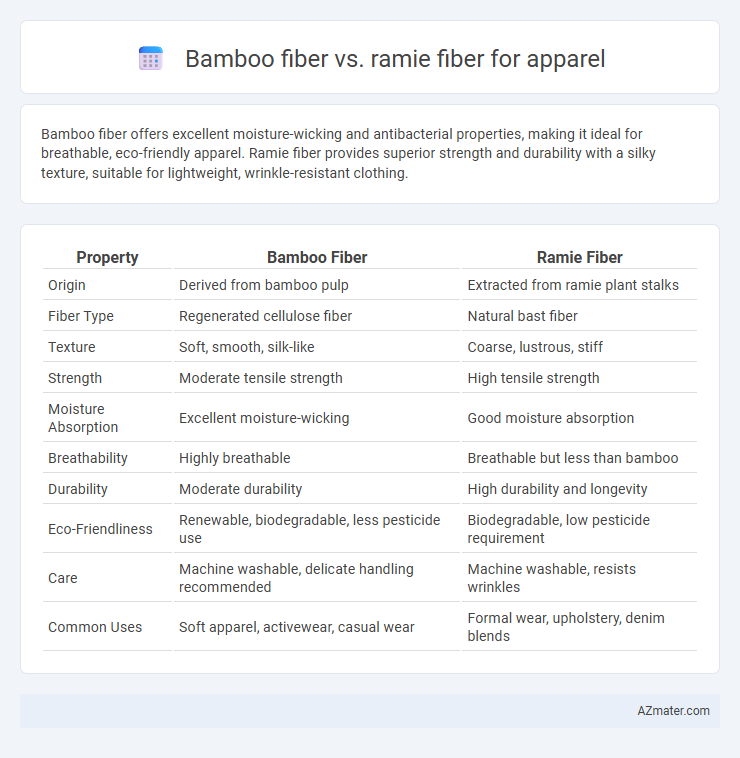Bamboo fiber offers excellent moisture-wicking and antibacterial properties, making it ideal for breathable, eco-friendly apparel. Ramie fiber provides superior strength and durability with a silky texture, suitable for lightweight, wrinkle-resistant clothing.
Table of Comparison
| Property | Bamboo Fiber | Ramie Fiber |
|---|---|---|
| Origin | Derived from bamboo pulp | Extracted from ramie plant stalks |
| Fiber Type | Regenerated cellulose fiber | Natural bast fiber |
| Texture | Soft, smooth, silk-like | Coarse, lustrous, stiff |
| Strength | Moderate tensile strength | High tensile strength |
| Moisture Absorption | Excellent moisture-wicking | Good moisture absorption |
| Breathability | Highly breathable | Breathable but less than bamboo |
| Durability | Moderate durability | High durability and longevity |
| Eco-Friendliness | Renewable, biodegradable, less pesticide use | Biodegradable, low pesticide requirement |
| Care | Machine washable, delicate handling recommended | Machine washable, resists wrinkles |
| Common Uses | Soft apparel, activewear, casual wear | Formal wear, upholstery, denim blends |
Overview of Bamboo and Ramie Fibers
Bamboo fiber is derived from the cellulose of bamboo plants, known for its softness, moisture-wicking properties, and natural antibacterial qualities, making it popular in sustainable apparel. Ramie fiber, obtained from the stalks of the Ramie plant, is recognized for its strength, durability, and ability to blend well with other fibers, enhancing fabric resilience and texture. Both fibers offer eco-friendly alternatives, with bamboo excelling in comfort and breathability while ramie provides robust structural support in textiles.
Source and Production Process
Bamboo fiber is derived from the pulp of bamboo grass using chemical or mechanical processing methods, often involving eco-friendly closed-loop systems to minimize environmental impact. Ramie fiber originates from the stalks of the Ramie plant, where natural degumming processes separate the fiber, followed by mechanical extraction and refining for textile applications. Both fibers offer sustainable alternatives with bamboo favored for its rapid growth and softness, while ramie provides strength and luster due to its traditional plant-based extraction.
Physical Properties Comparison
Bamboo fiber exhibits superior moisture-wicking and antibacterial properties compared to Ramie fiber, making it ideal for activewear and sensitive skin apparel. Ramie fiber offers higher tensile strength and excellent wrinkle resistance, enhancing durability and maintaining fabric appearance in formal wear. Both fibers provide breathable, lightweight fabrics, but Bamboo's softness contrasts with Ramie's slightly coarse texture, influencing comfort and garment application.
Comfort and Wearability
Bamboo fiber offers superior softness and moisture-wicking properties, making it highly comfortable for apparel, especially in warm climates. Ramie fiber is more durable and breathable but tends to be stiffer, which may affect its wearability for sensitive skin or casual wear. Both fibers provide natural antibacterial benefits, yet bamboo fiber's smooth texture enhances comfort over prolonged use.
Moisture Absorption and Breathability
Bamboo fiber excels in moisture absorption, capable of absorbing up to 40% more water than cotton, making it highly effective at keeping the skin dry and comfortable during wear. Ramie fiber, though less moisture-absorbent, offers superior breathability due to its natural hollow fiber structure, which promotes better air circulation and cooling. Apparel combining bamboo's moisture-wicking properties with ramie's breathability provides an optimal balance for activewear and summer clothing.
Durability and Longevity
Bamboo fiber offers moderate durability with natural antibacterial properties, but it tends to weaken faster than ramie fiber under frequent washing and wear. Ramie fiber is known for its superior strength and resilience, maintaining fabric integrity and appearance longer in apparel applications. Choosing ramie fiber enhances longevity and durability, especially for garments subjected to regular use and heavy wear.
Environmental Impact and Sustainability
Bamboo fiber boasts rapid growth rates and requires minimal pesticides, making it a highly renewable option for sustainable apparel production. Ramie fiber, derived from the nettle plant, is biodegradable and demands significantly less water than cotton, contributing to lower environmental footprints in textile manufacturing. Both fibers offer eco-friendly alternatives, with bamboo excelling in fast renewability and ramie providing durability and reduced chemical usage.
Dyeing and Color Retention
Bamboo fiber exhibits excellent dye absorption due to its porous structure, resulting in vibrant and long-lasting colors ideal for apparel. Ramie fiber, known for its high crystalline cellulose content, offers superior dye affinity, especially for reactive and vat dyes, enhancing colorfastness in garments. Both fibers demonstrate strong color retention properties, but bamboo's natural antibacterial qualities help maintain fabric brightness and reduce fading over time.
Cost and Availability
Bamboo fiber offers a cost-effective alternative to traditional textiles, with production costs typically lower due to the rapid growth and high yield of bamboo plants, making it widely available in Asia and increasingly accessible worldwide. Ramie fiber, although known for its strength and luster, tends to be more expensive and less available commercially because it requires labor-intensive processing and is primarily cultivated in limited regions such as China and Brazil. The relative affordability and broader distribution of bamboo fiber make it a popular choice for sustainable apparel manufacturing, while ramie's niche market limits its widespread adoption despite its desirable textile qualities.
Best Uses in Apparel Applications
Bamboo fiber excels in moisture-wicking and antibacterial properties, making it ideal for activewear, casual wear, and children's clothing that require breathability and softness. Ramie fiber offers exceptional durability and a silky luster, suitable for formal wear, summer garments, and blended fabrics that benefit from its wrinkle resistance and strength. Both fibers are sustainable choices, but bamboo is favored for comfort and antimicrobial performance, while ramie is preferred for its aesthetic appeal and fabric longevity.

Infographic: Bamboo fiber vs Ramie fiber for Apparel
 azmater.com
azmater.com